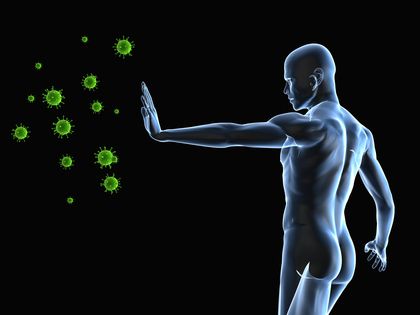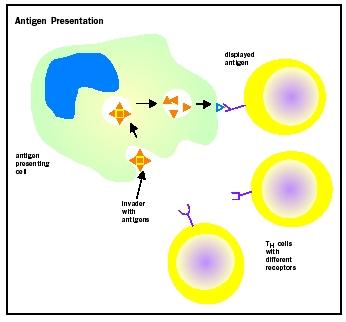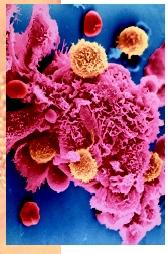Immune Response

Among the many threats organisms face are invasion and infection by bacteria, viruses, fungi, and other foreign or disease-causing agents. All organisms have nonspecific defenses (or innate defenses) that provide them with some of the protection they need. This type of defense exists throughout the animal kingdom, from sponges to mammals. Vertebrate animals, however, have an additional line of defense called specific immunity. Specific immunity is also called acquired immunity, adaptive immunity, or, most simply, an immune response.
Overview
One characteristic of specific immunity is recognition. Immune responses begin when the body recognizes the invader as foreign. This occurs because there are molecules on foreign cells that are different from molecules on the body's cells. Molecules that start immune responses are called antigens . The body does not usually start an immune response against its own antigens because cells that recognize self-antigens are deleted or inactivated. This concept is called self-tolerance and is a key characteristic that defines immune responses.
A second characteristic is specificity. Although all immune responses are similar, each time the body is invaded by a different antigen, the exact response is specific to that antigen. For example, infection with a virus that causes the common cold triggers a response by a different set of cells than infection with bacteria that causes strep throat.
A third characteristic is memory. After an antigen is cleared from the body, immunological memory allows an antigen to be recognized and removed more quickly if encountered again.
Antigen Presentation
Three groups of white blood cells are involved in starting an immune response. Although immune responses can occur anywhere in the body these cells are found, they primarily occur in the lymph nodes and spleen. These organs contain large numbers of antigen-presenting cells (APCs), T lymphocytes (or T cells ), and B lymphocytes (or B cells).
APCs include macrophages, dendritic cells, and B cells. These cells encounter the foreign invader and present the invader's antigens to a group of T cells called helper T cells (T H cells). APCs do this by first engulfing an invader and bringing it inside the cell. The APC then breaks the invader apart into its antigens and moves these antigens to its cell surface.
Receptors are cell surface proteins that can attach to antigens. Each T H cell has a different receptor, allowing each cell to recognize a different antigen. The APC "shows" the antigen to the T H cells until there is a match between a T H cell receptor and the antigen. The contact between the two cells stimulates the T H cell to divide rapidly. This process is called clonal selection because only the T H cells that recognize the foreign invader are selected to reproduce. Stimulated T H cells also produce chemical messengers called cytokines. Cytokines are made by all immune cells and control the immune response.

Antigen Clearance
The large numbers of T H cells activate two other populations of white blood cells: cytotoxic T cells (T C cells) and B cells. Like T H cells, each T C cell and B cell has receptors that match one antigen. This is why the immune system can recognize millions of antigens with specificity. The cells with the appropriate receptor encounter the antigen, preparing them for activation. They receive the final signal necessary for clonal selection from T H cells and cytokines.
Cloned T C cells attach to invaders they recognize and release a variety of chemicals that destroy the foreign cell. Because this must happen through cell-to-cell contact, it is called cell-mediated immunity (or cellular immunity). It is especially effective at destroying abnormal body cells, such as cancerous cells or virus-infected cells.
Cloned B cells destroy foreign invaders differently. After activation by T H cells, B cells release proteins called antibodies. Antibodies travel through the body's fluids and attach to antigens, targeting them for destruction by nonspecific defenses. This type of immune response is called antibody -mediated immunity (or humoral immunity). It is especially effective at destroying bacteria, extracellular viruses, and other antigens found in body fluids.
Immunologic Memory
A primary immune response happens the first time that the body encounters a specific antigen. It takes several days to begin and one or two weeks to reach maximum activity. A secondary immune response occurs if the body encounters the same antigen at a later time. It takes only hours to begin and may peak within a few days. The invader is usually removed before it has a chance to cause disease. This is because some of the cloned T C cells and B cells produced during a primary immune response develop into memory cells. These cells immediately become activated if the antigen appears again. The complex interactions among cells described above are not necessary.

In fact, this is what happens when an individual is immunized against a disease. The vaccination (using weakened or killed pathogens ) causes a primary immune response (but not the disease) and the production of memory cells that will provide protection if exposed to the diseasecausing agent.
Immune System Disorders
Studying immune responses also allows scientists to understand immune system diseases. For example, hypersensitivity disorders occur when the immune system overreacts to an antigen, causing damage to healthy tissues. The result of this excessive antibody and T C cell activity can be relatively harmless (as with allergies to pollen, poison ivy, or molds) or deadly (as with autoimmune diseases or allergies to bee venom and antibiotics).
At the opposite end of the spectrum are immunodeficiency diseases, conditions in which the body does not respond effectively against foreign invaders. HIV (human immunodeficiency virus) infection causes AIDS (acquired immunodeficiency syndrome) by attacking T H cells. Occasionally an individual is born with a deficient immune system, but these disorders are usually acquired (for example, from radiation treatment, chemotherapy, or infection with HIV). Whatever the cause, the individual has a more difficult time fighting infections.
Because immune responses exhibit the characteristics of self-tolerance, specificity, and memory, a healthy body is well equipped to remove foreign invaders and prevent recurrent infections. Age, nutrition, exercise, and stress all affect the ability of the body to fight disease.
SEE ALSO AIDS ; Antibody ; Autoimmune Disease ; Nonspecific Defense
John M. Ripper
Bibliography
Beck, Gregory, and Gail S. Habicht. "Immunity and the Invertebrates." Scientific American 275, no. 5 (1996): 60–65.
Friedlander, Mark P., Jr., and Terry M. Phillips. The Immune System: Your Body's Disease-Fighting Army. Minneapolis, MN: Lerner Publications Company, 1998.
Gustav, J. V. "Life, Death, and the Immune System." Scientific American 269, no. 3 (1993): 53–62.
National Institutes of Health. Understanding the Immune System. Washington, DC: National Institutes of Health, 1993.
Paul, William. E. "Infectious Diseases and the Immune System." Scientific American 269, no. 3 (1993): 90–97.
Comment about this article, ask questions, or add new information about this topic: